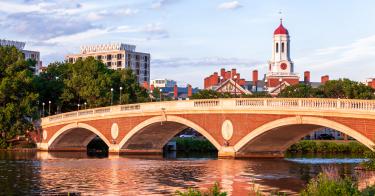For me, last month's Supreme Court argument in the Harvard affirmative-action case was personal. Growing up poor in Los Angeles, as the son of Colombian immigrants, I faced my share of racist taunts and stereotyping. In high school, I recall my White French teacher asking where I wanted to go to college. I said the Naval Academy. In front of all the other students she blurted, "You can’t go THERE!"
And you know what? She was right. I went to Harvard Law School instead.
But how exactly did a kid with my background get to Harvard, and what did affirmative action have to do with it? As with many things in life, the answer is complicated.
Between high school and law school, I went to the University of Southern California and encountered a veritable cornucopia of affirmative action programs for Black and Hispanic students. I became an INROADS intern and scored four straight summer internships at Bank of America. As a McNair Scholar, I got privileged access to free summer housing, professors and research resources to boost my chances of becoming an academic.
>>> The Real Dispute at Heart of Affirmative Action Cases Now Before High Court
These opportunities and more were all laid out for me on a silver platter—but I was always uneasy about it.
I had a Chinese American girlfriend at the time who was raised by a single mom and came from the same city I did. She was bright and ambitious and outpaced my affirmative action colleagues in academic, written and oral presentation skills, but she was Asian American and that fact alone disqualified her from these opportunities. The injustice of the situation eventually became too much for me, so I pledged not to participate in any more race-segregated programs.
My next step was grad school at Carnegie Mellon University where I flourished. But not everyone did. I tutored a struggling classmate who clearly lacked the skills and preparation for CMU’s graduate level work. I was furious at the administration for setting her up for failure, so I questioned the admissions director about the school's admission practices. He told me that his primary mission was boosting the number of Blacks and Hispanics and proudly showed me a special list he kept for tracking his numerical progress. Then it dawned on me. I had been on that list, and so had my struggling classmate, because she was African-American.
Around this time, I attended an event featuring Ward Connerly—the driving force in ending affirmative action in California's public universities. During the Q&A, I volunteered that I was applying to law school and asked Connerly point blank, "should I check the box?" He paused and said that he wouldn’t blame given the huge benefits offered, but ultimately said "it’s up to you."
I had a killer GPA, but it wasn’t from an Ivy League school and about 50% of Harvard Law students came from the Ivies at the time. I thought I had a great LSAT score, but great in this context was "only" average for Harvard. In short, I had a strong application, but my admission wasn’t a given. It would all depend on how I compared to all the other applicants. Or perhaps not.
>>> Red State Coalition Halts Biden’s Cancellation of Student Loan Debt
Hispanics going to top law schools at the time had LSAT scores 6.87 points lower on average than Whites, with Black students trailing a full 9.30 points behind. This meant that vanishingly small numbers of Blacks and Hispanics were scoring in the first percentile, which is the Harvard sweet spot. Before applying I pored over publicly available LSAT statistics and realized that I placed among the highest scoring fraction of a percent of Hispanics in the country.
By checking the box, my place at Harvard would be assured. So, I said a prayer, filled out the forms, and left the box empty.
My heritage and my life choices mattered then as they do now. But I refused to let my worth and my story be reduced to a neat little box. I refused to risk taking a spot from a more-qualified student because they happened to be Asian American or White. But most of all, I didn’t check the box because I wanted to be able to say, without hesitation, that I got into Harvard Law School because of my father’s hard work, my mother’s fervent prayers, and my own exertions. No stigma, no guilt, no self-doubt and most important of all, no guarantee of failure or success. Just a fair shot.
That’s the freedom that comes from not checking the box. That’s what equal opportunity truly means. I hope the Supreme Court agrees.
This piece originally appeared in Fox News




